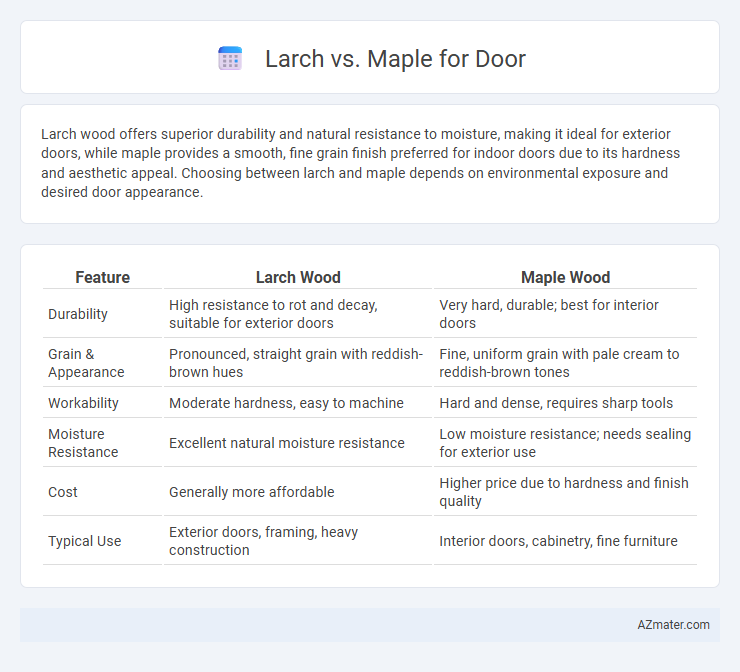Larch wood offers superior durability and natural resistance to moisture, making it ideal for exterior doors, while maple provides a smooth, fine grain finish preferred for indoor doors due to its hardness and aesthetic appeal. Choosing between larch and maple depends on environmental exposure and desired door appearance.
Table of Comparison
| Feature | Larch Wood | Maple Wood |
|---|---|---|
| Durability | High resistance to rot and decay, suitable for exterior doors | Very hard, durable; best for interior doors |
| Grain & Appearance | Pronounced, straight grain with reddish-brown hues | Fine, uniform grain with pale cream to reddish-brown tones |
| Workability | Moderate hardness, easy to machine | Hard and dense, requires sharp tools |
| Moisture Resistance | Excellent natural moisture resistance | Low moisture resistance; needs sealing for exterior use |
| Cost | Generally more affordable | Higher price due to hardness and finish quality |
| Typical Use | Exterior doors, framing, heavy construction | Interior doors, cabinetry, fine furniture |
Larch vs Maple: Overview
Larch wood, known for its durability and natural resistance to moisture, is often preferred for exterior doors in damp climates, offering excellent longevity and a rustic appearance. Maple, prized for its fine, uniform grain and hardness, provides smooth finishes and a more refined aesthetic ideal for interior doors requiring a polished look. Both larch and maple offer distinct advantages in door construction, with larch excelling in weather resistance and maple in visual appeal and strength.
Wood Grain and Aesthetic Differences
Larch wood features a pronounced, straight grain with a warm, reddish-brown hue that deepens over time, offering a rustic and natural aesthetic ideal for doors seeking durability and a rugged charm. Maple presents a smoother, more subtle grain pattern with a lighter, creamy color that allows for a sleek, modern appearance, making it a popular choice for contemporary door designs. The distinct grain textures influence the finishing options, where larch showcases rich, textured stains while maple enhances clean, polished looks through clear or light varnishes.
Durability and Strength Comparison
Larch wood offers high durability with natural resin content that enhances resistance to rot and insect damage, making it suitable for exterior doors exposed to harsh weather. Maple provides exceptional strength and hardness due to its dense grain structure, often used for interior doors where impact resistance is critical. While Larch excels in moisture resistance, Maple is favored for its superior structural rigidity and smooth finish.
Resistance to Moisture and Decay
Larch wood offers superior resistance to moisture and decay compared to maple, making it an excellent choice for exterior doors exposed to harsh weather conditions. Its high resin content and dense grain structure enhance durability and prevent water absorption, reducing the risk of rot and fungal growth. Maple, while strong and aesthetically pleasing, is more prone to moisture-related damage and requires additional treatments to improve its resistance.
Workability and Ease of Installation
Larch wood offers moderate workability with a fine, straight grain that allows for easier cutting and shaping, making it suitable for door installation, while its natural durability reduces the need for extensive pre-treatment. Maple provides excellent workability due to its smooth texture and uniform grain, allowing for precise machining and effortless sanding, which facilitates quicker and cleaner door fitting. Both woods are compatible with standard hardware, but maple's consistent density often results in easier screw holding and fastening compared to the slightly tougher larch.
Cost and Availability
Larch wood is generally more affordable and widely available in regions with cold climates due to its fast growth and natural resistance to decay, making it a cost-effective option for door construction. Maple, on the other hand, tends to be more expensive because of its dense grain and aesthetic appeal, coupled with higher demand and limited regional supply. When choosing between larch and maple for doors, consider that larch offers a more budget-friendly and accessible material, while maple commands a premium price but provides superior durability and visual appeal.
Maintenance Requirements
Larch wood requires regular sealing and treatment to prevent moisture damage due to its high resin content, making maintenance vital for longevity in door applications. Maple doors, known for their dense and hard grain, demand less frequent upkeep but benefit from occasional refinishing to preserve their smooth surface and resistance to wear. Both woods need protection against UV exposure to avoid discoloration, with larch doors requiring more intensive maintenance cycles compared to maple.
Environmental Impact and Sustainability
Larch wood, known for its natural durability and resistance to decay, offers a sustainable option for doors due to its fast growth rate and lower environmental footprint compared to slower-growing hardwoods like maple. Maple doors, while harder and denser, often require more energy-intensive processing and longer growth periods, resulting in a higher carbon footprint. Choosing larch supports reforestation efforts and reduces reliance on non-renewable materials, making it a greener choice for environmentally conscious construction.
Best Applications for Larch and Maple Doors
Larch doors excel in outdoor applications due to their natural resistance to moisture, decay, and insects, making them ideal for exterior entry doors, garden gates, and patio doors. Maple doors are best suited for interior use where durability and a smooth, fine grain finish are desired, such as in interior room doors, closet doors, and cabinetry. Larch offers superior weather resistance, while maple provides an elegant appearance and hardness for high-traffic indoor environments.
Final Verdict: Which Wood Is Better for Doors?
Larch wood offers exceptional durability and resistance to moisture, making it ideal for exterior doors exposed to harsh weather conditions. Maple provides a smooth, fine grain and superior hardness, resulting in a sleek, elegant appearance perfect for interior doors with high aesthetic demands. Overall, larch excels in outdoor durability while maple stands out for refined indoor applications, guiding the choice based on environmental exposure and desired door style.

Infographic: Larch vs Maple for Door
 azmater.com
azmater.com